
Grass and Plant Diseases
PYTHIUM BLIGHT
SYMPTOMS Pythium blight first appears as small, sunken, circular patches up to 1 foot in diameter during hot, humid weather. Leaves within the patches are matted, orange or dark gray in color, and greasy in appearance. Gray, cottony mycelium may be seen in the infected areas when the leaves are wet or humidity is high. The disease spreads rapidly along drainage patterns and can be tracked by equipment. This disease can spread rapidly and cause severe damage to a turf stand very quickly when conditions are favorable for development.
Click here for a free estimate form!
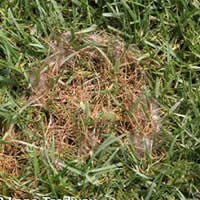

Characteristics
Description
Host Grass Species
bentgrass, bluegrasses, fescues, ryegrasses
Month(s) with symptoms
June to August
Stand Symptoms
patches (4 to 12 inches), irregular distribution across turf stand
Foliar Symptoms – Location/Shape
blighting of entire leaves
Foliar Symptoms – Color
tan, brown, black, gray, orange
Root/Crown Symptoms
none
Fungal Signs
mycelium or none
FACTORS AFFECTING DISEASE DEVELOPMENT
Pythium blight may develop when night temperatures exceed 65°F and leaves are continually wet for 12 to 14 hours for several consecutive nights. Daytime temperatures above 85°F also encourage Pythium blight development, possibly due to increased stress on the turf. Severe Pythium blight epidemics are commonly observed the morning after a late afternoon or early evening thunderstorm in the summer. Excessive soil moisture and succulent foliar growth also favor disease development.
Perennial ryegrass and annual bluegrass are most prone to Pythium blight and can sustain significant damage in 2 to 3 days when conditions are favorable. Creeping bentgrass and tall fescue are more resistant to the disease, but can be severely affected if conditions are conducive for prolonged periods.
CULTURAL CONTROL
Reduce prolonged leaf wetness by watering before sunrise and on a deep and infrequent basis. Avoid excessive rates of nitrogen to prevent lush, succulent foliar growth, which is very susceptible to Pythium blight. Cool-season turfgrasses should not be fertilized with more than 0.25 lb N per 1000 ft2 when conditions favor Pythium blight activity. Avoid establishing turf in low-lying areas that will collect water. If necessary, install subsurface drainage to prevent wet soil conditions. Relieve compaction and maintain soil drainage through hollow tine aerification, and topdress golf course putting greens regularly to minimize thatch accumulations.
Do not mow or irrigate when Pythium mycelium is present on the foliage to minimize spread of the pathogen. Collect and promptly dispose of clippings from infected areas and ensure that mowing equipment is washed before going to an uninfected area.
CHEMICAL CONTROL
Due to the potential for rapid development of this disease, high value areas and susceptible grasses should be protected with a preventive fungicide program. Applications should be initiated when night temperatures consistently exceed 65°F and repeated on 14 to 21 day intervals as directed on the fungicide label.
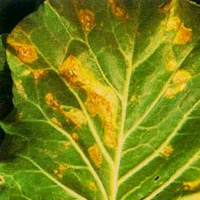
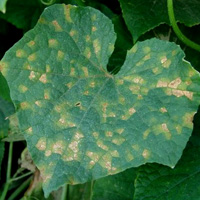
Downy Mildew can usually be found on the underside of the leaves and not just on the top of the leaves. Downy mildew begins with yellow leaf lesions that appear as indefinite yellow or brownish areas on the upper leaf surface that represents a spore producing fungus. The fungus grows within pods covering the seed with a white crust of spores. The texture of downy mildew is cottony or fuzzy. The disease is disfiguring and growth may be stunted. The disease is usually more severe in moist shaded areas.
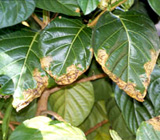
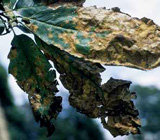
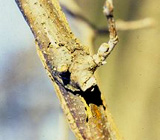
Anthracnose is a group of diseases found on many deciduous and evergreen trees and shrubs; some trees such as sycamore, ash, and evergreen elms can be noticeably blighted. Often called leaf, shoot, or twig blight, anthracnose results from infection by any of several different fungi, depending on the tree attacked. Anthracnose symptoms vary with the plant host, weather, and time of year infection occurs. Small tan, brown, black, or tarlike spots appear on infected leaves of hosts such as elm or oak. Dead leaf areas may be more irregular on other hosts such as ash. Sycamore anthracnose lesions typically develop along the major leaf veins. If leaves are very young when infected, they may become curled and distorted with only a portion of each leaf dying.
Generally, mature leaves are resistant to infection, but when conditions are favorable, they may become spotted with lesions. Heavily infected leaves fall prematurely throughout the growing season, and sometimes trees are completely defoliated. Early leaf drop is usually followed by production of more leaves. Twigs and branches also may be attacked and killed, resulting in a tree with crooked branches.
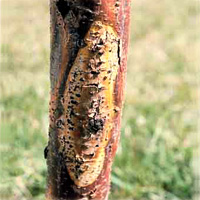

Canker Disease Aspen, cottonwood, mountain ash, willow and elm trees with environmental or weather-related stress are often more susceptible to canker diseases. These diseases also strike thin-barked trees that are susceptible to sun burns. A canker is an inverted blister on the bark of the tree which, during some time of the year, may ooze sap. A canker forms on branches or trunks of trees. Fungi, very small organisms that produce spores and mold-like material, cause most canker diseases. Leaves of a tree affected by these fungi begin to turn yellow and may drop to the ground. Some limbs may not develop new leaves in the spring. In severe cases, trees may die if canker disease isn’t
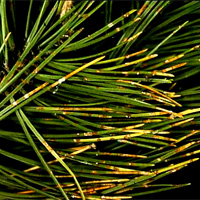

Dothistroma Needle Blight is a common fungal disease that causes browning of needles of Austrian, ponderosa, and mugo pines. Affected needles have reddish brown spots or bands. The needle tips beyond the bands dry out and turn brown a couple weeks after the bands appear, while the bases remain green. Diseased needles may drop prematurely, several months after they are infected. Typically, the most severely affected branches are towards the bottom of the tree.
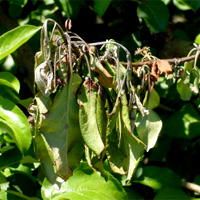

Fire Blight is the enemy of rosebushes and apple and pear trees. It is caused by a bacteria (erwinia amylovora) which attacks starting generally from the blossoms or flowers and moving up to the twigs and then the branches. Fire blight gets its name from the burnt appearance of affected blossoms and twigs. Flowers turn brown and wilt; twigs shrivel and blacken, the ends often curling. In more advanced cases of bacterial infestation, cankers, discolored oozing patches, form on branches. The translucent amber or reddish ooze contains masses of bacteria.
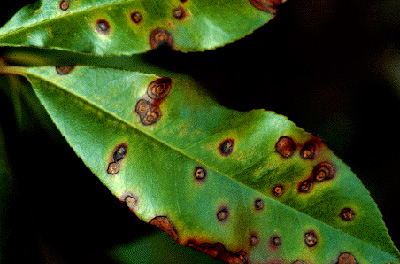
Leaf Spots are caused by a variety of fungi and some bacteria on many trees. An especially harmful version of this disease is called anthracnose which attacks many tree species including dogwood and sycamore. Positive identification usually requires laboratory diagnosis. A leaf spot disease creates spots on foliage. The spots will vary in size and color depending on the plant, the organism involved and the stage of development. Spots are most often brownish, but may be tan or black. Concentric rings or a dark margin around the spot may be present. Over time the spots may combine to enlarge and form blotches. Spots or blotches that are angular and located around the veins are generally referred to as anthracnose. Leaves may yellow and drop prematurely.
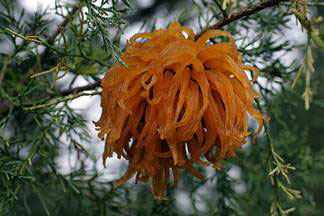
Cedar Apple Rust This disease is very common on juniper or cedar trees in Oklahoma. The most striking feature of this disease is the gall that appears on the cedar in the spring. Long, orange, gelatinous tendrils or horns develop from these galls and homeowners can easily recognize these structures and know that this disease is active.
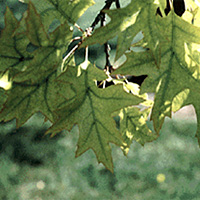

Iron Chlorosis – Affected leaves turn a yellowish color while the leaf veins remain a dark green. Iron chlorosis is caused by the plant not being able to obtain the iron it needs. Iron is needed for the production of chlorophyll. Therefore, a lack of iron results in a loss of the green color in the leaves. Symptoms may appear over the entire tree, on one side only, or be limited to individual branches. In severe cases, leaf color may change from yellow to white to brown. If uncorrected, twigs and eventually branches may die leading to the death of the tree.
Most Susceptible Trees: Pin oak, silver maple, baldcypress, crabapple and sweet gum. Can also affect white pine, elm, London planetree, cottonwood, walnut, sugar maple, Eastern redcedar, Bradford pear and willow.
Click here for a free estimate request form!
WE PROVIDE SERVICES TO THE FOLLOWING CITIES, TOWNS AND SURROUNDING REGIONS OF OK:
P.O. Box 31385 Edmond, OK 73003, Office: (405) 341-7998
Privacy Policy | Legal Notice | Site Map
Site by Equippedmarketing.com